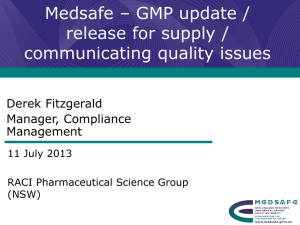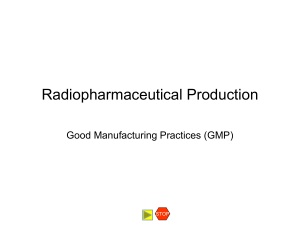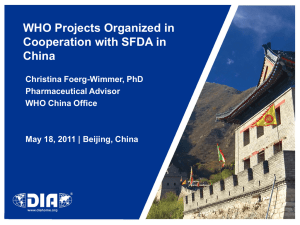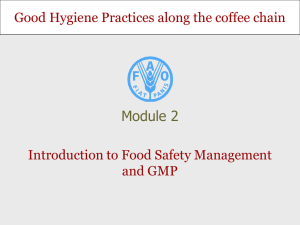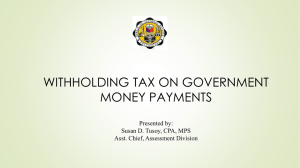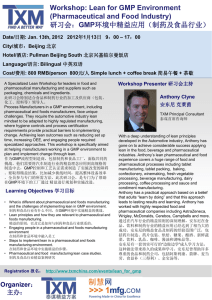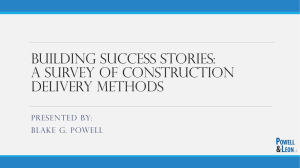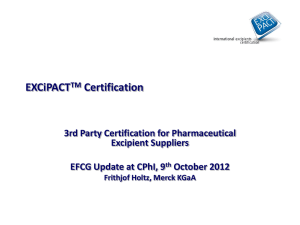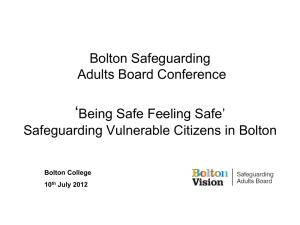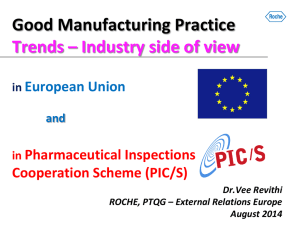Company name DEPARTMENT Management of GMP
advertisement
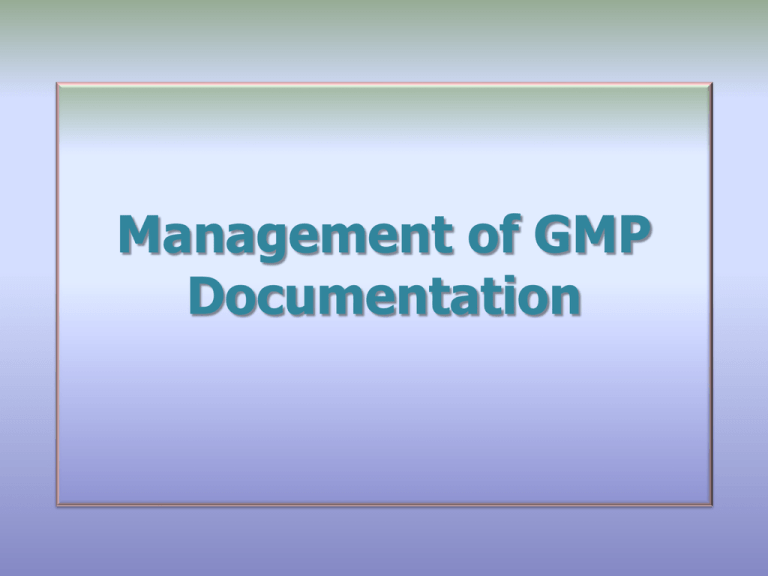
Management of GMP Documentation The Overview • • • • • • General Aspects and Requirements Types of GMP Documentation Purposes of GMP Documentation The Structure of Document Management Evaluation of the Documentation System The Document Management Cycle Some Remarks at the Beginning • GMP documentation is one critical aspect of our business and it is a legal requirement too! • Inspection or audit observations frequently identify outdated documents, inadequate version control, and poor documentation practices • As the Quality Unit is responsible for designing and operating the GMP documentation systems on site, such audit observations reflect on QA either directly or indirectly. What are the Definitions ? • GMP Documentation can be defined as: Any procedure, instruction, logbook, record, raw data, manual, or policy associated with the development, manufacture, testing, marketing, and distribution of a medicinal product required to demonstrate compliance with the GMPs and other regulatory requirements • Or more shortly: A GMP document is any written record associated with the manufacture, control and distribution of the API or pharmaceutical product. What are the Responsibilities ? • The site Quality Manager is responsible for ensuring that: • the systems to manage and control GMP documentation are available and comply with GMP requirements • all GMP documents in the documentation management system are in compliance with the regulatory files and GMP requirements. • The site functional Information Solution (IS) Head is responsible for: • supporting systems that assure integrity and availability of any electronic GMP documentation. General Aspects and Requirements The System Approach • Each site or facility handling GMP documentation must have systems and procedures for their management and control. • These systems and procedures must be compliant with company policies and GMP requirements. • Documentation subject to company policies must be identified and defined within the documentation management system. General Aspects and Requirements What should be recorded ? • All important information that is generated during an operation or process must be recorded together with who performed the operation and when it was carried out. • Such information should be legible, accurate, dated, traceable, and accessible. • This information should reflect the complete history of the manufacture, packaging and control of the product. General Aspects and Requirements Key Features of Good Documentation • Careful design of documents should make them easy to read, easy to understand and easy to complete properly • Original documents should be easily distinguishable from photocopies, and should have clear and concise information • Good documents should have sufficient space for entries, to record variable information and signature and to attach print-outs etc. Unused empty fields should be crossed-out. General Aspects and Requirements What else is relevant? • GMP documentation must clearly state title and content and must possess a site unique identifying number • GMP documentation must be formally approved, issued and version controlled • Data entries must be made or completed at the time the action is performed • Entries in logbooks should be done in chronological order. General Aspects and Requirements What else is relevant? • Master documents must be subject to appropriate controls to ensure that only one version is current. Such documents must be approved, signed and dated • Modifications to master documents must be managed through change control • There must be a periodic review of GMP documents to ensure that they are compliant with current regulatory files and GMP requirements. General Aspects and Requirements What else is relevant? • All information contained within GMP documentation that is stored and maintained electronically must be made available in both electronic and human readable formats • All SA product and system related documents are considered the intellectual property of SA and must be maintained and distributed in a confidential manner. Types of GMP Documentation (1) • This Documentation includes, but is not limited to the following Batch Related Records: Master Batch Records (e.g. Processing Instructions, (Packaging Instructions) Batch Records (e.g. Batch Production Records) Raw Data Records Laboratory Records Distribution Records Standard Operating Procedures (SOPs) Specifications and Test Methods Records of Raw Materials, Intermediates, Labelling and Packaging Materials Types of GMP Documentation (2) • Non Batch related Records Qualification and Validation Documents Change Control Documentation Engineering Drawings Maintenance and Calibration Records Complaint Records Recalls and Returns Environmental Monitoring Records Utility Monitoring Records Line and Equipment Logs Types of GMP Documentation (3) • Non Batch related Records (continued): Personnel Training Records Quality Agreements (i.e. Technical Agreements) Failure Investigation and Reporting Records Cleaning and Sanitization Records Entry Records for Controlled Areas Pest Control Records Stability Records Audit and Regulatory Inspection Reports Regulatory Files Types of GMP Documentation (4) • Some other examples of documentation that must not be forgotten: SOP Annexes Computer files Process Flow and other Diagrams (e.g. gowning diagrams) Raw Data Sheets (charts, chromatograms, etc.) Technical Reports Labels (room and equipment status, sampling, material status) Purposes of GMP Documentation (1) • There are three main purposes for GMP documentation: To meet legal requirements including all GMP expectations To meet our business requirements To form the basis of good scientific decision making Purposes of GMP Documentation (2) “If it is not documented, it is a rumour!” This is the FDA Inspection Approach Purposes of GMP Documentation (3) • To understand what needs to be done (the process) • To understand how to do it (the method) • To understand why it needs to be done (the context) • To understand who must do it (the responsibility) • To understand when to do it (frequency, close out) • …. At the end: to ensure that there is an adequate record of who did what, when, how and why! Purposes of GMP Documentation (4) • If you cannot answer all of the questions from the previous slide, then the documentation (system) has somehow failed • Remember, documentation should equally be for our own benefit as it is for the regulators • And: inspections normally provide good feedback for improvement. Purposes of GMP Documentation (5) •PROCEDURES SHOULD BE WRITTEN AND FOLLOWED •It is a concern if an SOP has not been in place •But it is a violation of the GMP requirements, if the SOP is present, but not followed. Purposes of GMP Documentation (6) Documenting Decisions and Rationales • The regulators expect things to occasionally go wrong during manufacturing or testing • However, we must ensure that we clearly document and sign off our decisions with a rationale behind • In reality, this is one area of a general weakness • During many audits, people can explain precisely why an action was taken. Although the decision may have been the correct one and documented, the rationale was never documented/signed off at the time. The Structure of Document Management Taking a Logical Approach • There should be one “umbrella” document (SOP) that defines the management of GMP documentation, our approach to documentation • For example: What type of documents are covered by GMP What is raw data and what not Who is responsible for each GMP documentation Who can author, review, and approve GMP documents How working copies are controlled How the documents are archived When the documents are reviewed for changes The Structure of Document Management Control of Working Copies • It is important to have the most up to date working copy of a document issued to a department. But how can we stop uncontrolled copies being photocopied (e.g. replacement page of BMR) • It is easier now for people to make uncontrolled copies as they have general access to photocopy machines. • Apart from rigorous training, many different methods are used to help control documentation Batch number punched through all pages of BMR copy BMR Copy stamped in red with batch number and date SOP’s red stamped with controlled copy and the number of the copy. The Structure of Document Management • Document Administration Department • • • Centralized better than de-centralized? Reporting Relationship Must be audited like all other GMP related departments • • • Logical and easy to understand Identifies revisions No duplication • • • • • Writing, reviewing, and approving Numbering and version control Issuing Retrieving Retention and Archiving • Document Numbering System • Document Management Procedures The Structure of Document Management Retention and Archiving • Require clear rules and procedures about archiving of superseded documents Defined Retention Periods No loss of Information during retention (thermal printers) Fire and waterproof archives Access and Control of document archives Readily Retrievable (in case of compliant, recall, audit) Periodic Checks of archive Electronic Archives to be Qualified and Validated Document destruction • Note the archived documents are the property of the company. Even if the site is sold, and documents must be transferred to another site and secured in a storage area The Structure of Document Management Document Retention Rules • The retention period for all quality documentation must meet legal and regulatory requirements of all relevant markets. • It is the responsibility of each department to ensure the control and retention of GMP Documents in accordance with the systems and procedures. Evaluate the Documentation System (1) • We need to review whether our documentation system is working correctly or not • It is easy to make general statements to the effect that: “nobody fills out the documents correctly” “there are always problems with the documentation” “the system does not work” • As with any other process, we need to collect and analyse real data to see if there is a problem or not, or to identify whether performance is improving or not. • It is a well known phenomenon that improvements will occur just because people know that we are measuring it. Evaluate the Documentation System (2) • Some examples of what we can review and evaluate: % % % % % % SOP’s not reviewed within the required time frame Batch Records with missing information at review time of logbooks not reviewed within the correct time frame of uncontrolled technical drawings of outdated versions of SOPs versus the master copy of superseded documents not retrieved Are there certain issues within specific departments? Are some systems badly out of control? Make the data transparent Ask users why they believe current system is not working Compare systems that work well with those that do not • Identify the priorities and the reasons The Documentation Management Cycle (1) FOLLOW-UP / MONITOR MAKE EFFECTIVE TRAINING VERSION CONTROL REVIEW AGAIN DRAFT REVIEW APPROVAL The Documentation Management Cycle (2) Document Drafting • Written procedures need to be drafted in a way that will help avoid errors: clear instructions written in sufficient detail well understandable version controlled written with a view for training defining the responsibilities easy to implement. The Documentation Management Cycle (3) Document Drafting • The document is only useful if the person who should use it, actually understands it • Therefore consider the following aspects when drafting documents: educational level cultural background linguistic ability comprehension ability readability Index for average English: 13 words per sentence. The Documentation Management Cycle (4) Document Review • What can be reviewed and evaluated when checking individual documents? the information that is stated the information that is not stated/missing steps scientifically incorrect information/requirements conflicting requirements safety issues legal/regulatory issues the rationale for the document (is the document serving a useful purpose). The Documentation Management Cycle (5) Document Approval • GMP Documentation is normally signed by the following persons: Author: a knowledgeable and trained person in the relevant topic within the relevant department (QA only author their own documents!) Reviewer: who is someone equally proficient as the author Approver: an appropriate level of management (normally the QA manager). • Quality Assurance main role is to review and approve that all GMP documents are in compliance with regulatory files and meets the GMP requirements. • The QA signature is therefore the last one to be added. The Documentation Management Cycle (6) Version Control • Effective Version Control is an essential part of the GMP document management system • There must be a high level of confidence that only the latest versions of documents exist as working copies • There are two ways of dealing with superseded versions • Passive retrieval (not recommended) The new document is issued and the recipient is asked to destroy all copies of the superseded one (rarely happens) • Active retrieval (recommended) The new document is exchanged for the superseded version The Documentation Management Cycle (7) Training • New/Updated documents have been written for a reason, and it is essential that relevant people are informed/trained as appropriate before the document becomes effective • The document can be trained on a one to one basis or within a group. The document can be read by the relevant people • In some cases, there may be some short questions to answer to ensure that key aspects are understood. The Documentation Management Cycle (8) Training • People can generally have different preferences in their way of learning, but the most important thing is that the time for training is built into the cycle, and properly documented • The documentation system must ensure that absentees are also trained upon their return to work • The system must also ensure that the proof of training can be retrieved easily. The Documentation Management Cycle (9) Make Effective • The effective date of the document (e.g. SOPs, protocols) should permit enough time for training of relevant personnel • Procedures, once effective, should be as working documents, and treated as such • The best procedure is of no value in the supervisor’s locked office! • And then: Follow up and monitor! Summary and Conclusions (1) • GMP Documentation is one critical aspect of our business. • All documentation required by GMP regulations must be issued, managed, and controlled by a document management system. • QA have a major role to play in managing GMP documentation. • Inspections and audits regularly identify issues with documentation system. Summary and Conclusions (2) • Document management system needs to be clear and logical Use a top down approach (QA must take the lead!) Use flow chart and other tools to define documentation needs Includes all types of documentation (including electronic) Ensure a robust document cycle from drafting to archiving • Review and evaluate the performance of documentation system. Thank You Any Questions


